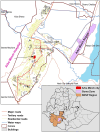Uncovering community needs regarding violence against women and girls in southern Ethiopia: An explorative study
- PMID: 38861511
- PMCID: PMC11166345
- DOI: 10.1371/journal.pone.0304459
Uncovering community needs regarding violence against women and girls in southern Ethiopia: An explorative study
Abstract
Background: Violence against women and girls (VAWG) is a significant global public health problem and a violation of human rights experienced by one in three women worldwide. This study explores community perceptions of and responses to VAWG and challenges in accessing support services among female violence survivors in Arbaminch City.
Methods: We adopted a phenomenological explorative qualitative study design. A total of 62 participants including female violence survivors, religious leaders, service providers, police, women, and men in participated in interviews, focus group discussions, and observations in August 2022. Participants were selected purposively, and the findings were analyzed thematically. We applied data source and respondent triangulation to increase the findings' trustworthiness.
Results: Community perceptions of VAWG, specifically of intimate partner violence (IPV) and non-partner sexual violence (NPSV), varied depending on gender, age, and social position. IPV and NPSV were normalized through tolerance and denial by young and married men, while resistance to all forms of violence was common among women. Survivors of violence responded to the act of violence by leaving their homes, separating from their husbands, or taking harsh actions against their husbands, such as murder. Support for VAWG survivors was available through health care, free legal services, and a temporary shelter. Yet factors ranging from individual to societal levels, such as fear, lack of knowledge, lack of family and community support, and social and legal injustice, were barriers to accessing existing services. Nonetheless, violence survivors desired to speak about their experiences and seek psychosocial support.
Conclusions: Our qualitative evidence gathered here can inform tailored VAWG prevention and response services such as interventions to shift social norms and the perception towards VAWG among different population group through raising awareness in schools, health care settings, faith-based venues, and using social media.
Copyright: © 2024 Admassu et al. This is an open access article distributed under the terms of the Creative Commons Attribution License, which permits unrestricted use, distribution, and reproduction in any medium, provided the original author and source are credited.
Conflict of interest statement
The authors have declared that no competing interests exist.
Figures



Similar articles
-
Lived experiences of intimate partner violence survivors during pregnancy and who had spontaneous abortions: A phenomenological study to inform survivor-centered strategies.Womens Health (Lond). 2024 Jan-Dec;20:17455057241305069. doi: 10.1177/17455057241305069. Womens Health (Lond). 2024. PMID: 39623805 Free PMC article.
-
Needs and unmet needs for support services for recently pregnant intimate partner violence survivors in Ethiopia during the COVID-19 pandemic.BMC Public Health. 2023 Apr 20;23(1):725. doi: 10.1186/s12889-023-15634-7. BMC Public Health. 2023. PMID: 37081421 Free PMC article.
-
Barriers in accessing intimate partner violence services: Intersecting views of immigrant and minority ethnic survivors and community organization workers.Womens Health (Lond). 2025 Jan-Dec;21:17455057251323091. doi: 10.1177/17455057251323091. Epub 2025 Mar 25. Womens Health (Lond). 2025. PMID: 40132146 Free PMC article.
-
Can This Provider Be Trusted? A Review of the Role of Trustworthiness in the Provision of Community-Based Services for Intimate Partner Violence Survivors.Trauma Violence Abuse. 2024 Apr;25(2):982-999. doi: 10.1177/15248380231168641. Epub 2023 May 3. Trauma Violence Abuse. 2024. PMID: 37132638 Review.
-
Natural hazards, disasters and violence against women and girls: a global mixed-methods systematic review.BMJ Glob Health. 2021 Apr;6(4):e004377. doi: 10.1136/bmjgh-2020-004377. BMJ Glob Health. 2021. PMID: 33958379 Free PMC article.
Cited by
-
Perceptions of Causes, Consequences, and Solutions of Intimate Partner Violence (IPV) in Mexican Women Survivors of IPV: A Qualitative Study.Behav Sci (Basel). 2025 May 24;15(6):723. doi: 10.3390/bs15060723. Behav Sci (Basel). 2025. PMID: 40564505 Free PMC article.
References
-
- Claudia García-Moreno Christina Pallitto, Devries Karen, Stöckl Heidi, charlotte Watts NA. Global and regional estimates of violence against women: prevalence and health effects of intimate partner violence and non-partner sexual violence. 2013.
-
- Watts CG-MAFMJEH. WHO multi-country study on women’s health and domestic violence against women: initial results on prevalence, health outcomes, and women’s responses. Swizterland: World Health Organization; 2005.
-
- Krug EG et al.. E. World report on violence and health. Geneva, World Health Organization: World Health Organization, 2002; 2002.
-
- Central Statistical Agency (CSA) [Ethiopia] and ICF. Ethiopia Demographic and Health Survey 2016. Addis Ababa, Ethiopia, and Rockville, Maryland, USA: CSA and ICF: CSA and ICF;
MeSH terms
LinkOut - more resources
Full Text Sources
Medical

